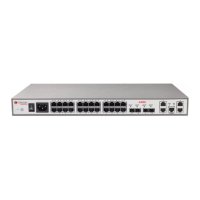A10E/A28E/A28F Configuration Guide
2.3 QinQ
2.3.1 Introduction
QinQ (also known as Stacked VLAN or Double VLAN) technique is an extension for 802.1Q
defined in IEEE 802.1ad standard.
Basic QinQ is a simple Layer 2 VPN tunnel technique, which encapsulate outer VLAN Tag
for user private network packet at the carrier access end, then the packet takes double VLAN
Tag to transmit through backbone network (public network) of carrier. In public network,
packet just be transmitted in accordance with outer VLAN Tag (namely the public network
VLAN Tag), the user private network VALN Tag is transmitted as data in packet.
This technique can save public network VLAN ID resource. You can mark out private
network VLAN ID to avoid conflict with public network VLAN ID.
Basic QinQ
Figure 2-3 shows typical networking with basic QinQ, with the A10E/A28E as the Provider
Edge (PE).
Figure 2-3 Typical networking with basic QinQ
The packet transmitted to the switch from user device, and the VLAN ID of packet tag is 100.
The packet will be printed outer tag with VLAN 200 when passing through PE device user
side interface and then enter PE network.
The VLAN 200 packet is transmitted to PE device on the other end by the carrier, and then the
other Switch will strip the outer tag VLAN 200 and send it to the user device. So the packet
returns to VLAN 100 tag.
Selective QinQ
Selective QinQ is an enhancement of basic QinQ. This technique is realized by combination
of interface and VLAN. Selective QinQ can implement all functions of basic QinQ, and can
even perform different actions on different VLAN Tags received by one interface and add
different outer VLAN IDs for different inner VLAN IDs. By configuring mapping rules for
inner and outer Tag, you can encapsulate different outer Tag for different inner Tag packet.
Selective QinQ makes carrier network structure more flexible. You can classify different
terminal users at access device interface by VLAN Tag and then, encapsulate different outer
Tag for different class users. On the Internet, you can configure QoS policy according to outer

